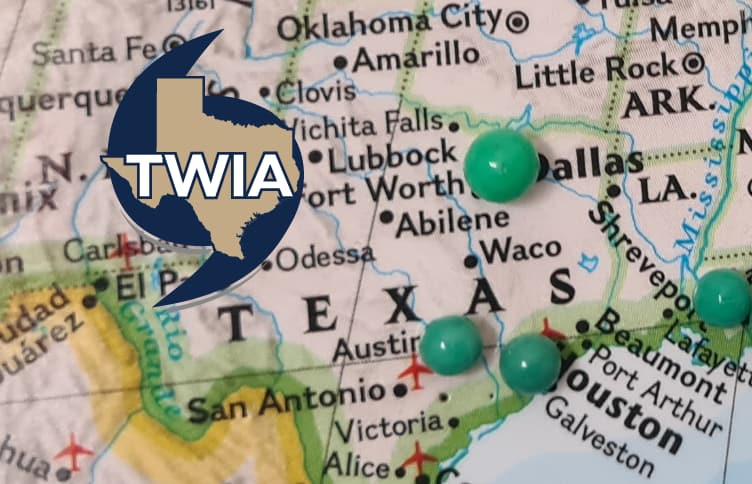TWIA needs almost $5.8bn in reinsurance for 2025, as CRTF eroded by Beryl, PML rises

The Texas Windstorm Insurance Association (TWIA) is looking at another relatively significant increase in its reinsurance purchase next year, as it projects it may need almost $5.8 billion of reinsurance and catastrophe bond limit, due to the near-erosion of its CRTF by hurricane Beryl and a still-rising PML.
Each year, TWIA goes through a budgeting process where it defines its 1-in-100 year probable maximum loss (PML), its available capital resources, and looks to build its funding tower using private market reinsurance and catastrophe bonds.
Last year, the Board of the Texas Windstorm Insurance Association (TWIA) approved a 1-in-100 year PML for 2024 funding purposes at a new high of $6.5 billion, which meant the insurer of last resort needed just over $4 billion in reinsurance limit for the 2024 wind season.
For 2024, TWIA had in place $2.1 billion of Alamo Re catastrophe bonds, as well as some $1.95 billion of traditional reinsurance.
Below the private market cat bonds and reinsurance, TWIA funded itself with the $450 million CRTF (catastrophe reserve trust fund) and $2 billion of member assessments and public securities, meaning that the private market risk transfer only attached at $2.45 billion of losses to the Association. You can see the 2024 TWIA funding structure and reinsurance tower here.
For 2025, things are changing and there will be a greater need for private market risk transfer, while the reinsurance attachment point could also need to adjust, perhaps coming down meaningfully.
At the bottom-end of the TWIA funding tower, losses from hurricane Beryl have risen and this is now anticipated to almost completely erode the CRTF.
TWIA said, “The ultimate loss and loss adjustment expense estimate for Hurricane Beryl is $455 million as of September 30, 2024. This amount is roughly equivalent to the current balance in the Catastrophe Reserve Trust Fund.”
Which reduces the funding at the very lowest-layer of the tower, which might mean the reinsurance arrangements need to drop-down to fill in some lower-layer risks as well, unless other funding sources are secured.
TWIA further said, “The Association anticipates higher reinsurance costs for 2025 because of the need to secure additional coverage due to the depletion of the Catastrophe Reserve Trust Fund to pay losses and loss adjustment expenses from Hurricane Beryl and increased policy exposures.”
TWIA’s projected 1-in-100-year PML, so the level it needs to fund itself up to according to statute, for 2025 is $7.8 billion, which is reflective of exposure being up by 20% on the prior year’s $6.5 billion.
Immediately that implies a potential need for $1.3 billion more in reinsurance and cat bonds, but then when you add in the fact the CRTF is almost fully-depleted the increased need for reinsurance is even larger.
In 2024, TWIA purchased $4.05 billion in reinsurance and cat bond coverage, but for 2025 the projection now is for a possible $5.795 billion to be required, which is a 43% increase.
TWIA projects that total estimated gross reinsurance premium for 2025 could reach $485 million, a big increase on 2024’s $397 million.
TWIA’s Board are going to have some key decisions to make as they approach 2025 and get into their regular rounds of meetings where the budget and risk transfer purchases will be discussed.
With such an increase in funding required, TWIA may look to other forms of funding than reinsurance and catastrophe bonds.
But, if the focus remains on filling the rest of the tower with risk transfer, then TWIA may be advised to get out early again in 2025 with a new catastrophe bond, well in advance of its traditional reinsurance placement, to lock in some of the investor appetite being seen.
The cat bond market can certainly support more Alamo Re catastrophe bonds, so given the increased need it seems likely we’ll see TWIA back in the market in the first-half of 2025, perhaps more than once.
One other point of note, TWIA’s other lever it can pull to reduce its PML and therefore funding need would be depopulation, so takeouts of policies by private market insurers.
However, TWIA’s Board heard this week that there is a lack of insurer interest in the program, so two recent depopulation rounds were cancelled as a result.
TWIA has been directly sponsoring catastrophe bonds since 2014 and is one of the largest sponsors in our cat bond market sponsor leaderboard.
You can read about all of TWIA’s Alamo Re catastrophe bonds it has ever sponsored in the Artemis Deal Directory.






